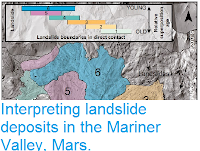The Tharsis Volcanic Province covers roughly a quarter of the surface of the planet Mars, with 12 major volcanic edifices and over a thousand smaller vents. The southernmost of the major volcanic structures is Arsia Mons, a shield volcano over 300 km which has a caldera 110 km across. Within this caldera, a total of 29 small volcanic vents have been observed, each with its own lava flow extending over part of the caldera floor. No impact craters larger than 1 km across have been observed inside the caldera, leading to the conclusion that it is relatively young; crater dating techniques (which estimate the age of surfaces on other Solar System bodies based upon the number of observable craters upon them, from the assumption that the random distribution of impacts proceeds at a constant rate), have suggested an age of no more than 130 million years.
In a paper presented at the 48th Lunar and Planetary Science Conference at The Woodlands, Texas, in March 2017, and accepted for publication in the journal Earth and Planetary Science Letters, Jacob Richardson of the Planetary Geology, Geophysics, and Geochemistry Lab at NASA’s Goddard Spaceflight Center, James Wilson of the School of Geosciences at the University of South Florida and DigitalGlobe, Charles Connor, also of the School of Geosciences at the University of South Florida, and Jacob Bleacher, also of the Planetary Geology, Geophysics, and Geochemistry Lab at NASA’s Goddard Spaceflight Center describe the results of a study of the nature and age of the volcanic vents and lava flows within the Arsia Mons Caldera.
Richardson et al. used Context Imager data to construct an ArcGIS baseamap with a 6 m/pixel resolution. Using this they were able to determine boundaries between the lava flows, enabling them to judge the extent of the lava flows derived from each vent; lava flows which could not be associated with a vent (probably because they have been overlaid by later flows) were excluded from the study. As all the images were taken from more-or-less directly above, it was impossible to determine the exact thickness of each lava flow; to model the approximate volume of the lava, a maximum thickness of 80 m and a minimum thickness of 10 m were used. Ages of the lava flows were estimated using crater density methods.
The Arsia Mons Caldera features 29 cataloged volcanic vents (black circles). Each vent effused lava flows 10s of km downhill. Flows are shaded by strati-graphic height, with uppermost flows lightly shaded and lower flows shaded dark red. Richardson et al. (2017).
The measured lava flows cover approximately 6700 km², roughly 70% of the caldera floor. They are estimated to have volumes of between 0.04 and 69 km³, with a total lava volume of 67-540 km³. Based upon the date estimates obtained, Richardson et al. estimate that the crater had a sharp increase in activity between 300 and 150 million years ago, and that activity declined to a halt between 90 and 10 million years ago, with an average of one major flow-producing event every 2.5 million years during this period, or an average of 1 to 8 km³ of lava being produced each million years.
See also...
Follow Sciency Thoughts on Facebook.







